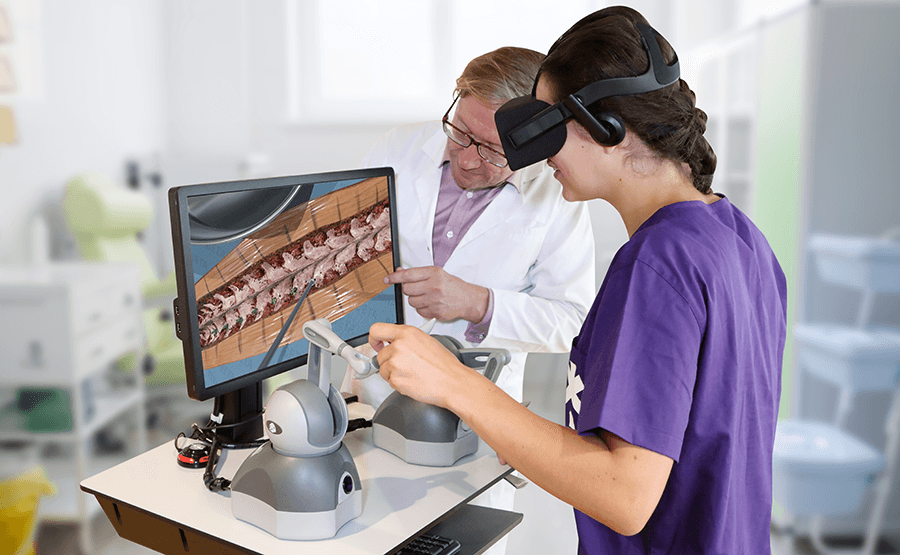Virtual reality and augmented reality have been increasingly used in healthcare for some time now. Especially in the medical field, this technology is increasingly used to simulate surgeries, to train surgeons or to study the anatomy of the human body in more detail.
War scenario Bravemind
Through VR, veterans can relive fictional war scenarios to confront terrible experiences and overcome post-traumatic stress disorder in a safe environment. As part of their therapy, the veteran is asked to confront their experiences and remember what war was like. The goal of these sessions is to make the remembered scenes more alive and accessible, and to work through them with a therapist. By now it is known that most patients have shown an improvement and reduction of their symptoms.

Training for Surgeries
The surgeon relying entirely on his AR glasses during surgery is still rather unthinkable these days, as technology is involved and failures can occur. However, there are some other ways of using AR glasses that are of great advantage and are already being used in some clinics. By being able to maintain all sterile conditions, they can be used to livestream and record surgeries or communicate with other people outside the operating room. The technology is most likely to be used for teaching and training medical students.

VR for people with visual impairments and those who are completely blind
At a conference in 2019, the SeeingVR toolset was introduced. It is intended to enable people who have poor eyesight or are blind to have virtual reality experiences but without having to create extra newly crafted VR experiences. This tool can be overlaid on top of an existing, traditional VR experience as long as the scenario was created using Unity. The tool works in a flexible way to be able to adapt to as many people as possible and to their needs. The user can adjust brightness, zoom in on elements, change contrast or change text color or size. In addition, objects were given brighter edges to highlight them and contours were given to the scene. A laser can be used to point to a text that is then read aloud.
Embodied Labs to simulate what its like to live with certain health conditions
One company developed labs that use VR simulations to help people experience what it feels like to have certain health conditions. One example of a simulation is Alfred. Alfred is a 74-year-old African-American man who suffers from both high-frequency hearing loss and macular degeneration (a disease of the retina of the eye). Individuals can put on the headset and perceive their surroundings from Alfred’s perspective. Technology is used to increase the volume when a user leans in the direction where the sound is coming from. After a period of time, the user is given a hearing aid to understand what difference the device is making. It is interesting that during tests, even though people read through the introduction, they immediately reported that something has to be broken or that the volume was too low.

Children with autism are taught social and communication skills
Floreo is a company that focuses on teaching social and communication skills to autistic children by combining VR with games or other activities and letting them practice certain scenarios. Through this method, children who are often overwhelmed by their real environment can practice and learn to cope in a virtual environment.

Detect visual impairments through AR
Using AR glasses and eye tracking, the company SyncThink can determine whether and to what extent visual impairments are present.

Unlearning the sensation of pain
The company Karuna helps people to exercise more to have less pain in their upper body or back. Learned pain or chronic pain is to be unlearned through a 12-week course. Common everyday scenarios or activities must be completed with the help of a VR headset and a tablet with instructions.
Improve physical health through VR therapy
Using VR can help people who have psychological problems. An example is fear of heights. Through therapy, a user can be exposed to heights in a protected, simulated environment and learn how to deal with it or try different things. A virtual couch is there to support and help.
Sources
- News Feature: Virtual reality therapy set for a real renaissance, M. Mitchell Waldrop (26.9.2017), https://www.ncbi.nlm.nih.gov/pmc/articles/PMC5625944/
- Using Google Glass in Surgical Settings: Systematic Review, Nancy J Wie, Bryn Dougherty, Aundria Myers, Sherif M Badawy (6.3.2018), https://www.ncbi.nlm.nih.gov/pmc/articles/PMC5861300/
- Microsoft Tools Bring VR Access to Low-Vision, Blind Users, Pamela Hogle (10.6.2019), https://learningsolutionsmag.com/articles/microsoft-tools-bring-vr-access-to-low-vision-blind-users?utm_campaign=lspub&utm_medium=link&utm_source=lspub
- Can virtual reality change the way we think about health?, Gordon Gottsegen (29.6.2019), https://builtin.com/healthcare-technology/ar-virtual-reality-healthcare
- 18 Healthcare Augmented Reality and Virtual Reality Companies to Watch, Kayla Matthews (29.6.2020), https://hitconsultant.net/2020/06/29/augmented-reality-and-virtual-reality-companies-to-watch/#.YBBhVS337ow
- Karuna, (2021), https://karunalabs.com
- Oxfordvr, (2021), https://ovrhealth.com